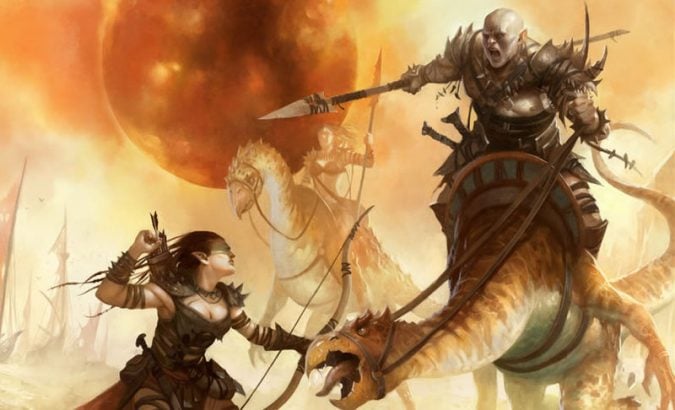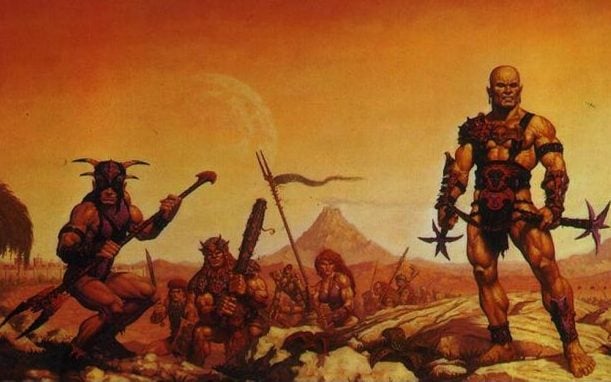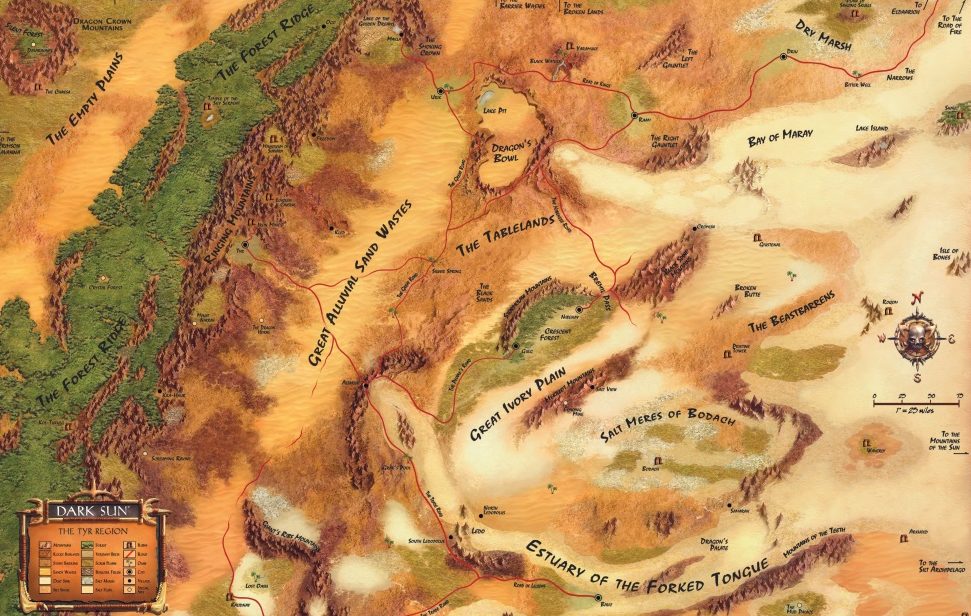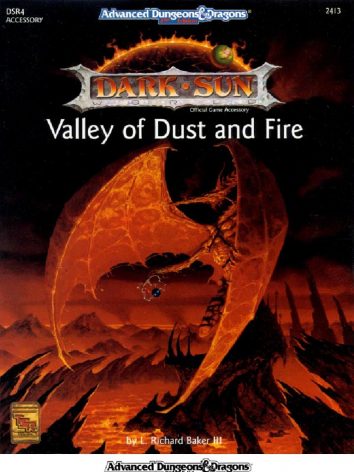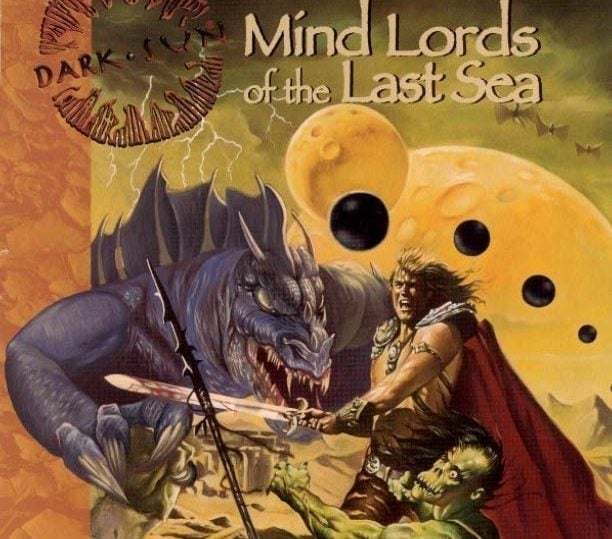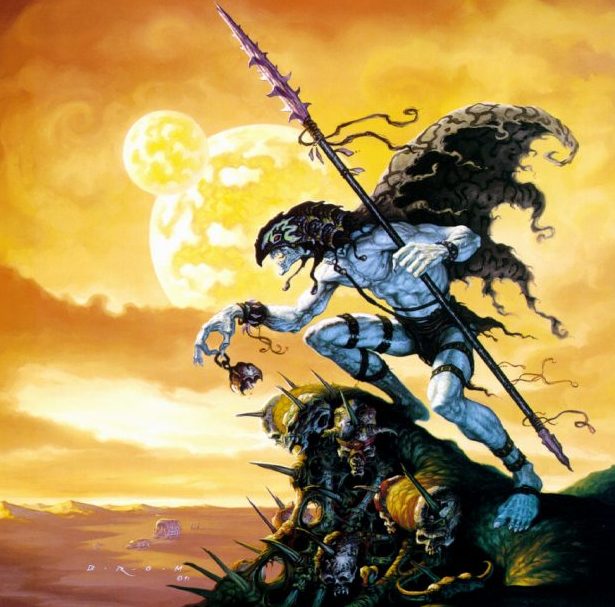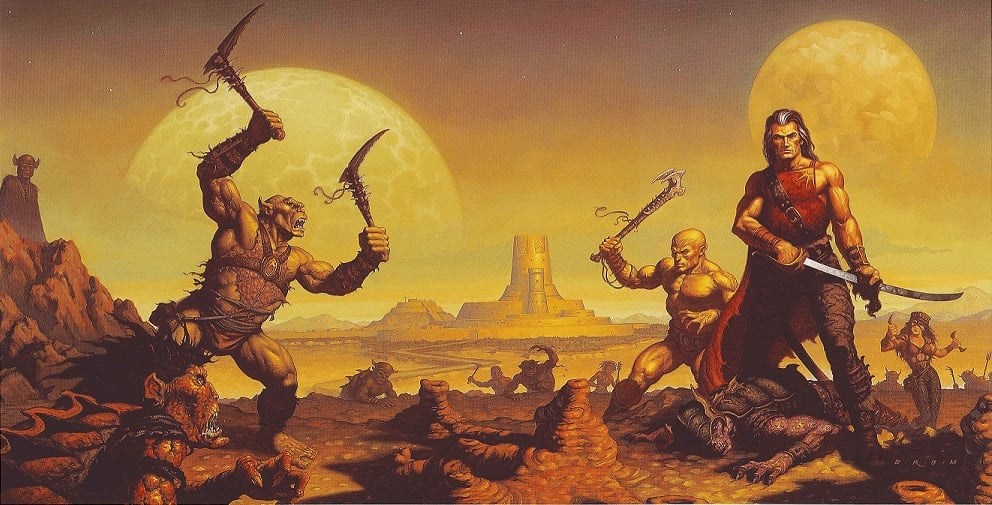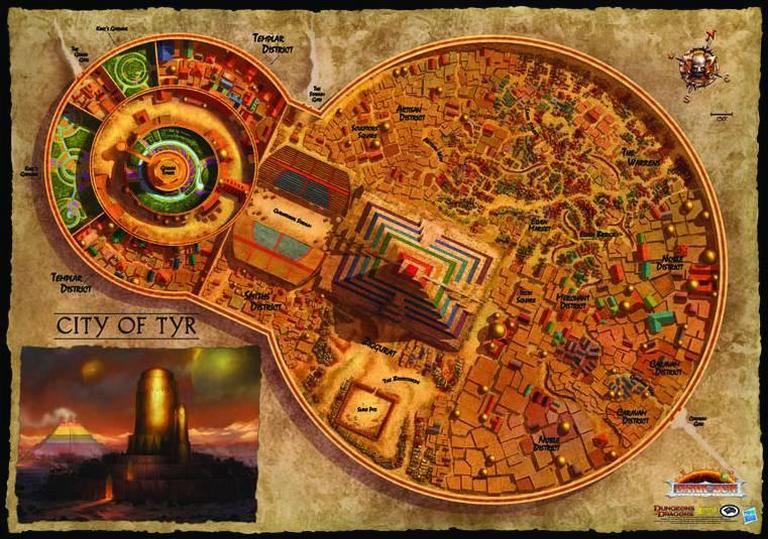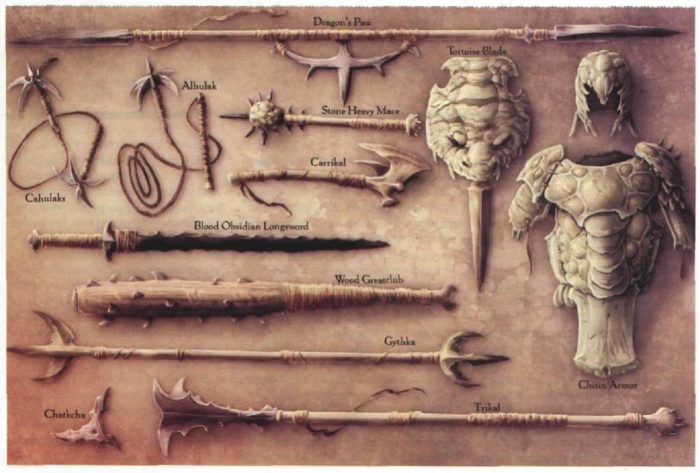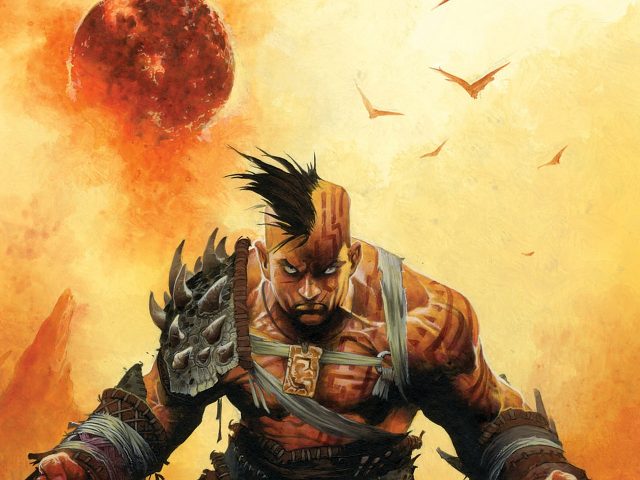Tour of the Planes: The Dark Sun of Athas
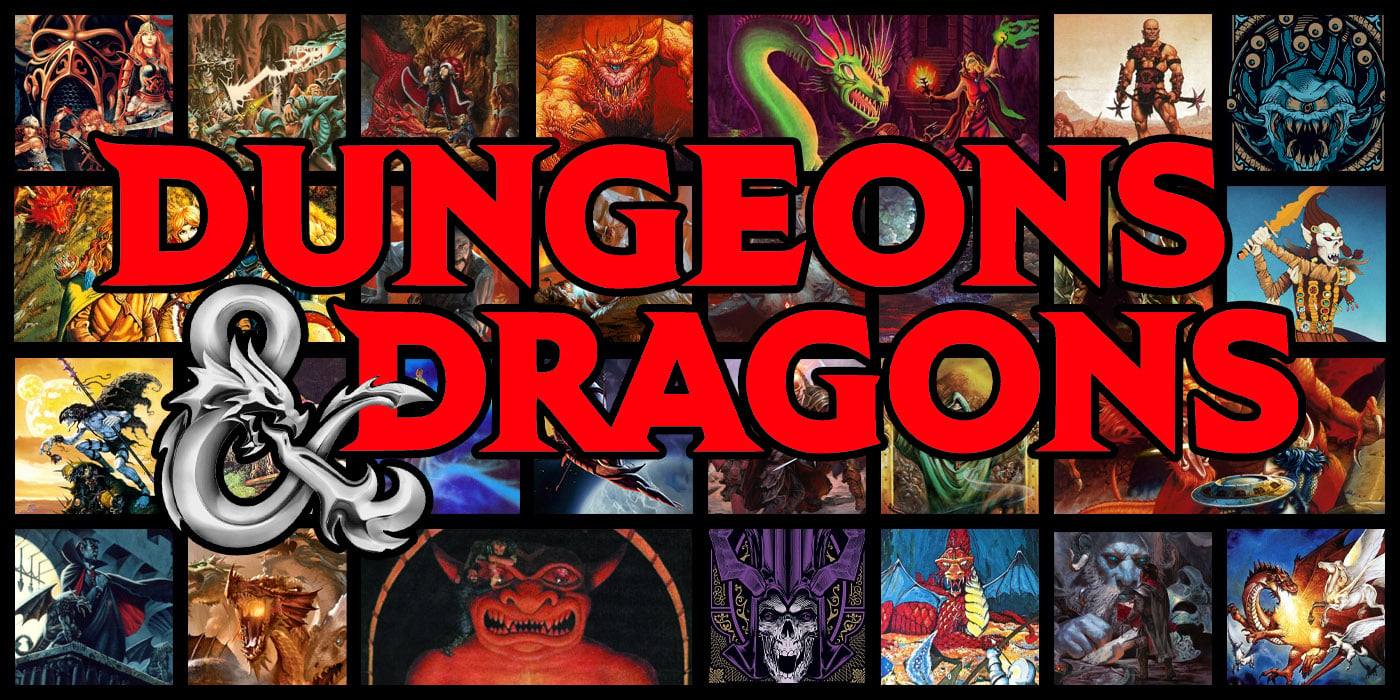

A blasted desert wasteland dotted by bastions of civilization ruled by immortal sorcerer-kings. Does the sun seem a bit dark to you?
Merry Yulemastidings Adventurers. With a Planar Setting book around the corner, we’re making a special trip to Dark Sun, Eberron, and Spelljammer. Join us on our tour of the planes–we’re going to get a little detailed with each of these, but for this week, we have an overview of each of these settings. Join us as we revisit an article from the ancient days of 2016 (it seems so long ago) and return to Athas.
That’s right. It’s time to strap on some chitin armor, secure your trusty alhulak, and take care not to stray too close to halfling lands–this week we’re visiting the desert world of Athas–the world of Dark Sun. Originally released in 1991, Dark Sun is a post-apocalyptic campaign setting that took the rules of D&D and spun them into something fantastic. Though the setting is one of the biggest departures from traditional fantasy, it enjoys a lasting following to this day
It stands out from the other settings–Athas feels different. It was designed to be. It was the first setting to be developed with an overarching metaplot that was meant to draw players into the struggles of the world. New races and classes were available to players, including the infamous thri-Kreen, (aka the reason your GM is twitchy when it comes to monstrous races), Aarakocra, and Pterrans, while more familiar races were given new twists that made them unique to Athas.
Even the rules were changed to fit the setting. Most notably, magic–the defining element of any fantasy setting–was made into something dangerous and feared. Magic was the tool that defiled the world. Arcane magic became synonymous with death and destruction. And divine magic was all but absent. Athas is not home to gods. It is a barren world, whose priests serve the elements. And, owing to the fact that the setting was developed alongside the Complete Psionics, psionics feature heavily into every facet of everyday life on Athas. The whole thing adds in a vaguely sci-fi flavor (which later products would play up). And then there’s the art, beautifully rendered by Brom, who basically was given free reign with the creation of the world. The story goes: Brom would paint something, and the writers would rush off to fit it into the world. Thus was Dark Sun created.
Visit scenic Athas! Stop by one of our body modification specialists for a free piercing today!
So what makes Athas tick? Geographically speaking, everything is terrible all the time. The majority of the campaign setting is is centered around the Tyr Region–the biggest bastion of “civilization” in the world. Here, the city-states of the immortal sorcerer-kings tower over the wastelands. In their walled enclaves, and the outlying villages, you’ll find most of the humans, humanoids, and thri-Kreen. There are seven in all: Tyr, Balic, Draj, Gulg, Nibenay, Raam, and Urik. Each has its own distinct culture and leanings, but all cleave to the same general societal hierarchy: at the very top are the sorcerer-kings (or dragon-kings), and then there’s everyone else. And at the bottom of everyone else, those unfortunate enough to be captured as slaves by one of the many races of slavers in Dark Sun. What else would you expect from a harsh world where dying from old age is considered an accomplishment, and something to be met with reverence or celebration.
West of the Tyr region, you’ll find the Ringing Mountains, so called for the ringing, light-headed sensation the lack of oxygen produces when trying to cross them. If you can survive the harsh desert depths and the arduous trek upwards (they sit at 10,000 feet above the “sea level”), you’ll find that the rumors of an untamed wilderness are true. The Forest Ridge lies beyond the Ringing Mountains–kept lush and green by hidden rivers and rainfall, it is a jungle teeming with life. And, like most everything in Athas, it is utterly hostile. It is home to the halflings, xenophobic and dangerous, and it is home to ancient ruins that lie buried beneath the thick canopies. Out beyond the forest ridge, where the heat finally chokes out the last of the vegetation, vast stretches of sand arise.
On the eastern edge of the Tyr region is the Sea of Silt. So named because it was once a sea, and then defiling magic transformed it into silt. Now it is no less habitable. The silt is not strong enough to support weight upon it, and it is incredibly fine, which means that without protective gear breathing becomes more of a challenge than usual on Athas, and that’s saying something. Within the Sea of Silt you can find such lovely tourist destinations as the Valley of Dust and Fire, a realm of shattered badlands that lies beyond a great ash storm that is sure to kill anyone trying to cross it. It goes without saying that the Valley of Dust and Fire is home to all manner of new monsters, waiting to say hello* to any traveler they come across.
I SAY HELLO WITH MY DEATH MAW DON’T YOU?
To the north are the Jagged Cliffs, another vast, trackless region of desert, bounded by the crimson plains (they’re crimson because of the sun and also blood) and the Sea of Silt. In the Jagged Cliffs are two more city-states: Eldaarich and Kurn, as well as the Crimson Savannah, which is full of sharp bamboo-like plants and an army of mantis-men. The various Kreen live here, in other words. So be on the lookout for chatkcha wielding assassins lurking in every corner. Should you not want to stay there, you could proceed even further north to the Burning Plains, where presumably, everything is on fire. Past that, however, is the Last Sea–the largest body of water left on Athas. It’s been preserved for ages by powerful psions. Naturally these psions have abandoned the need for a physical body, implanted their consciousness in obsidian gems, and been driven mad over the centuries.
Come see our sunny beach-side resort.
In the south, you’ll find the Dead Lands. There’s not much to say about them beyond the fact that they’re literally the lands where all the (un)dead hang out, and are considered to be inhospitable even by the hardiest of Athas’ inhabitants. This region was described in a book called the Terrors of the Dead Lands. That should tell you everything you need to know about them. Nobody goes there unless they have no other choice.
The history of Athas is just as friendly and easy-going as the geography. Much like Krynn, Athas has been through five ages:
- The Blue Age – when arguably, everything was fine. Halflings ruled the world right up until they destroyed the oceans.
- The Green Age – when the world didn’t end up dying, it was lush and verdant. Right up until Rajaat came along.
- The Red Age – when Rajaat, one of the setting’s big villains, discovered arcane magic, and then ruined everything.
- The Brown Age – when the sorcerer-kings rebelled against Rajaat and then rose to power.
- The Age of Heroes – when you come along.
Each one of these ages has its own particular impact on the setting that helps shape it into the barren wasteland it is in “present day.”
The Blue Age
This era was relatively peaceful. Halflings ruled over the vast ocean that covered much of the world. They wielded the power to shape the building blocks of life, called Life-Shaping. And these halfling “nature-masters” began to experiment on various life-forms. This in turn led to war, which ultimately leads to the creation of the Brown Tide, which is a magical alteration of the planet’s water, changing it from life-giving water to poison. Eventually they are able to turn the tide, but not until after life was all but wiped-out. The halflings created an artifact known as the Pristine Tower to destroy the brown tide, turning the sun from blue to yellow in the process.
The Green Age
After the destruction of the brown tide, the halfling nature-masters went into seclusion. Many retreated to the Ringing Mountains, and their magics are a large part of why the forest ridge is so verdant to this day. Those that didn’t, spread out into the world. During this time, religions start to spring up, but there are no true deities. People discover they have psionics, though, and for a while, life is relatively good. However, it is during this time that the pyreens appear–powerful psionics who are capable of creating great wonders. Among these Pyreen is Rajaat, a hideous but intelligent psion who discovers arcane magic. He teaches this power to many, though to a chosen few, he teaches the full extent of its power. He shows them ‘defiling’ a process which drains life from the world to fuel arcane power. Through sacrifice, defiling, and a powerful ritual, Rajaat turns his most loyal followers into his Champions, immortal beings of immense power who he tasks with cleansing the world. This ritual turns the sun a deep crimson shade.
The Red Age
This age begins with blood. A campaign of genocide is waged across the face of Athas, known as the Cleansing Wars. These wars last for hundreds, if not thosuands of years in some cases. The desolation is carried out by Rajaat’s Champions and their servitors. Though, as the carnage is carried out, the Champions begin to suspect that Rajaat may be wanting to kill all life on Athas, which includes them. Wisely, they decide to rebel against their master, and through powerful magic they imprison Rajaat in a realm known as the Hollow–a vast, empty void, where nothing exists. Not time, nor light, nor even darkness. In order to keep him there, the Champions enact another powerful ritual (and a whole bunch of sacrifice), turning one of their number, Borys, into a dragon. Borys then immediately goes mad and rampages across the world.
The Brown Age
Also known as the age of Sorcerer-Kings. This is the time when the sorcerer-kings rise to power. Their tyranny spreads across Athas as they seize what little power there is left in the world. They build or conquer the territories that will eventually become their city-states, and begin revising history to erase their misdeeds. The world continues to get worse, as they practice more defilement in order to maintain their power.
The Age of Heroes
Finally we come to the Age of Heroes. This is where the bulk of the story of Dark Sun takes place. It all begins with the assassination of Kalak of Tyr during a slave rebellion. This kicks off a series of wars, rebellions, and other such strife for players to get involved in. This storyline is advanced in adventure modules, as well as a series of novels, the Prism Pentad. This age wqas briefly updated during 3rd Edition, which had its events happening 200 years after the assassination of Kalak–but there were few products released, and the transition was very short-lived. With the advent of 4th Edition, the setting returned to the volatile Age of Heroes.
So why is Dark Sun so successful? Well, as you can tell from the history and the geography–this is a very different setting. I don’t think it’s the contrast with traditional fantasy or the savage nature of the setting alone that makes it work so well though. For me, it all comes down to the way the world is set up. I mentioned earlier that Dark Sun was the first setting that TSR developed that had a metaplot. And I think it’s from this metaplot that a lot of the meat of this campaign world derives.
It’s not necessarily about the resolution of the story–Krynn and Faerun have had their share of world shaking conflicts–but rather I think it’s the tension that the big plotline sets up that made it so compelling. The whole thing kicks off with the assassination of a sorcerer-king. This only means anything because of the history. We know that the sorcerer-kings are incredibly powerful, so even if you don’t dive deep into the lore of the setting (although it is pretty rich) there’s a natural tension created by this very event.
The world of Athas might be dying, but it is dynamic. It has a push and pull and a very real sense that events will one day resolve themselves. Compare this to the Forgotten Realms, which I also like, but which lack a sense of narrative tension. Much like an early 90’s sitcom–everything feels driven by the status quo. At the end of the day, the heroes are fighting to preserve the world. And the stories told in Faerun are all about safeguarding the realms from harm. Adventurers might work with the Harpers or the Lords of Waterdeep to try and keep the city from changing. It’s a world where stories happen, but ultimately you know that Neverwinter is still going to be there. Or that the Red Wizards of Thay will never conquer the world. In a way, the setting really can’t change.
They tried in 4th Edition. Faerun was hit by a world-shaking spellplague, and had a whole other plane merge with it temporarily–but people hated these changes. And when 5th edition rolled around, little mention of their effects was carried off. And it makes sense, the Forgotten Realms are explored, they’re very much a civilized world, not meant for the ‘points of light’ that defined 4th Edition.
But in Athas, for better or worse (often worse) we get a sense that this is a world that wants change. It is a world fraught with tension that cannot hold. But–and this is key–the tools for resolving the conflict aren’t spelled out from the outset. They are littered here and there in the setting. There’s talk of ancient treasures, or of other races that might help–but ultimately the fate of things is left vague.
Which is why I think they reverted the changes from 3rd Edition. A big part of the appeal of Athas is that you know that there’s all these pre-existing tensions in the world, and they’ll be playing out no matter how your campaign goes. Even if you choose to ignore it completely and just be desert wanderers, the campaign world is still effected by the choices of the people in its history–the tension the developers built into the setting makes it feel that much more alive.
Then you make the imaginative leap into post-apocalyptic fantasy and add all manner of changes–there’s a whole specialized list of equipment that exists because metal is rare in Dark Sun, and all these cultural weapons have sprung up as a response–and you get a world that people can really sink their teeth into. You get a world that people feel like they can be a part of–a world that people feel like they can do something about.
And that’s why I think Dark Sun enjoys so much love to this day. While Faerun is a world you fight to save, Athas is a world you fight to survive in. A world you fight to change.
Got a favorite Dark Sun story? Ever seen raider ships on fire off the coast of the Silt Sea, or thri-Kreen skittering in the dark near the silent forest? Let us know in the comments below.


